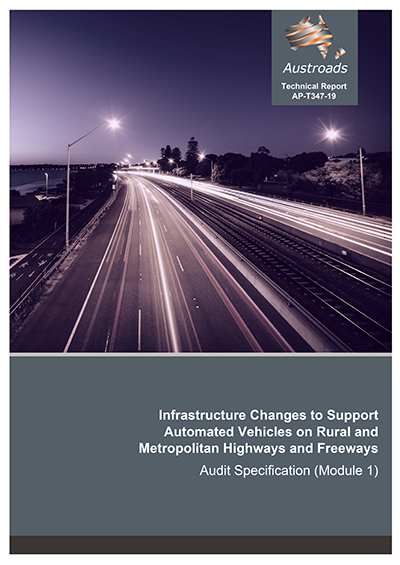Connected and Automated Vehicles

- Publication no: AP-T347-19
- ISBN: 978-1-925854-46-6
- Published: 8 October 2019
- PDF (free) Download
By 2025, it is predicted that most new vehicles will be equipped with systems that can read traffic lines and signs. The purpose of this project (FSP6088) is to identify areas of current physical and digital road infrastructure on key highways and freeways in Australia and New Zealand that automated vehicles using machine vision systems can and cannot interpret.
This first module recommends specifications to be used in an audit of road infrastructure. These specifications cover line marking, traffic signs, route and lane discontinuities, temporary conditions due to roadworks and incidents, cellular data coverage and availability of map data.
The development of these specifications follows an extensive review of local and international literature, initiatives and lessons learned from field trials, complemented by engagement with local and international industry stakeholders.
- Summary
- 1. Introduction
- 1.1 Report structure
- 2. Background Research
- 2.1 What data do automated driving functions need?
- 2.1.1 AVs understanding the world around them – sensors and data sources
- 2.2 What test requirements apply to vehicle and systems manufacturers?
- 2.2.1 Test procedures for line marking recognition and lane support systems
- 2.2.2 Test procedures for traffic sign recognition
- 2.3 What international benchmarks exist?
- 2.3.1 EuroRAP and EuroNCAP: Roads that Cars Can Read
- 2.3.2 US NCHRP Road Markings for Machine Vision
- 2.4 What do US stakeholders think is important?
- 2.4.1 3M submission
- 2.4.2 Alliance of Automobile Manufacturers’ submission
- 2.4.3 American Association of State Highway and Transportation Officials (AASHTO) submission
- 2.4.4 National Committee on Uniform Traffic Control Devices (NCUTCD) submission
- 2.5 How do available benchmarks compare to Australian and New Zealand standards, specifications and maintenance practices?
- 2.6 Lessons from local and international research and testing
- 2.6.1 Austroads CAV program: traffic sign recognition
- 2.6.2 Austroads CAV program: FPI6119 Pavement Markings for Machine Vision
- 2.6.3 Field testing on Australian motorways
- 2.6.4 International field testing results
- 2.7 Summary of key findings from background research
- 2.7.1 Considerations for developing audit specifications
- 2.1 What data do automated driving functions need?
- 3. Industry Engagement
- 3.1 Engagement with the automotive industry
- 3.1.1 General
- 3.1.2 Line marking and pavement marking
- 3.1.3 Traffic signs
- 3.1.4 Digital infrastructure – communications and mapping
- 3.1.5 Timeframes for automated driving
- 3.2 Engagement with local projects testing infrastructure suitability for automated driving
- 3.3 Engagement with consultants: introduction to machine vision
- 3.1 Engagement with the automotive industry
- 4. International Engagement
- 5. Audit Specifications
- 5.1 Introduction
- 5.2 General
- 5.3 Line marking
- 5.4 Signs, speed limits and traffic restrictions
- 5.5 Temporary conditions for roadworks, incidents and events
- 5.6 Route and lane discontinuities
- 5.7 Mobile data availability
- 5.8 Map data availability
- References
- Appendix A Introduction to Machine Vision
